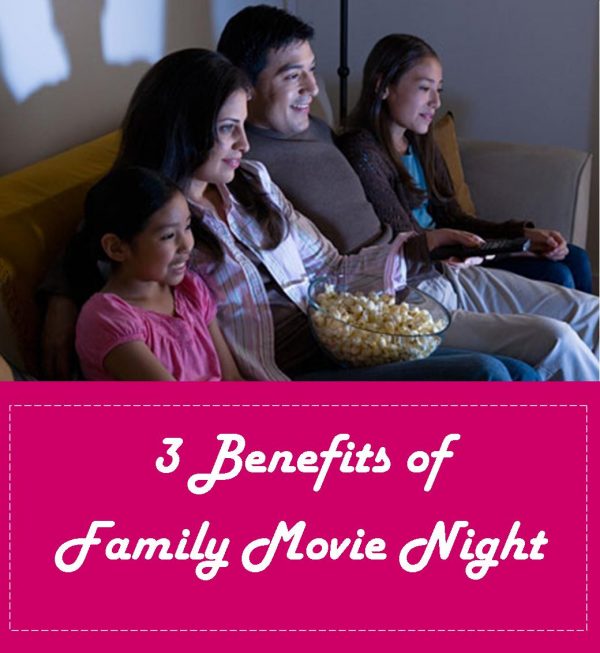On more than one occasion our Holy Father has urged parents to “waste time with your children.” Great advice! We need to give ourselves permission to “do nothin’” with our kids. In the Cameron-Smith home, one of our favorite ways to waste time together is with a family movie night! Nothing signals my brain that it’s time to relax than when my 8 year old grabs the popcorn maker and the other kids drag out their pillows and blankets to create their cozy viewing nests. Aside from movie night being plain fun, here are three practical benefits:
1. Helps you teach the story map
Every story – including the story in a movie – has the same basic structure. After the movie, see if your kids can identify these story elements:
• PROGAGONIST AND CONFLICT REVEALED: In the beginning, the main character (the protagonist) is introduced, and we quickly learn about the main conflict: some struggle, force, or goal that the main character is facing. There’s usually an antagonist – an enemy – though not necessarily a human being. The antagonist might be nature or an animal.
• RISING ACTION: The rising action is where the plot develops. The main character confronts obstacles and new characters as she deals with the conflict.
• CLIMAX: The climax is the turning point in the story. The main character is at a crossroad; the conflict could be resolved in different ways depending on the outcome of her actions at this point.
• FALLING ACTION and RESOLUTION: After the climax, the story wraps us and the writers ties up loose ends. This is called falling action. We find out what happens to the character because of the climax. How has she changed; what has she learned because of her experience?
Movies always have a theme – usually many themes. The theme might be about family, love, honor, or fear. Discuss the themes of the movies you’re watching. What messages is the screenwriter trying to send about these topics? The message might be something like “family will get you through any challenge” or “facing your fears will help you conquer them.” You’ll be very surprised by the insights even young children have. Older children and teenagers will often want to debate the themes, and this is healthy and fun as long as everyone is respectful.
Your kids will start noticing these story elements in books they read. Practically speaking, this is great for academic performance. But this knowledge also helps them enjoy books more because will begin seeing different layers and meaning in every story they encounter. Instead of being passive readers, their minds become actively engaged as they respond to the unfolding of the story elements.
2. Provides an opportunity for us to train our children in compassion and empathy
Human beings are born with a capacity for empathy, but it’s only a capacity: children need particular experiences in childhood in order for that capacity to unfold. One of these experiences is gentle mentoring from parents about what other people are thinking and feeling. Movies provide an easy, fun way to do this mentoring. When a person in the movie is frightened, sad, or angry we can talk to our kids about that character’s perspective and experience. You don’t have to quiz your kids; just engage them in natural conversation. Ask questions like “what do you think John was feeling when he couldn’t find his dog?” or “I wonder if Jane was sad or frustrated when her friend called her a name?” This gives kids an opportunity to exercise their empathy muscles in a non-threatening way.
3. Opens up discussion about our Catholic values
Just talking about what we like and don’t like in a movie opens up conversation, but watching movies with our kids also gives us a chance to communicate with them about morality, virtue, and the consequences of our choices.
After the movie, ask your kids what they think the main problem was in the story. How did the protagonist try to solve their problem? Was she/he successful? Ask your child how she might have done things differently. Talk with your kids about which Christian virtues were present or lacking in particular characters and their choices. For example, did the different characters demonstrate or lack charity, obedience, honesty, humility, fidelity, or modesty?
Talk to your kids about your family’s Catholic identity and values. What is your family’s unique mission statement? Are the movies we want to watch strengthening or weakening your shared values? With older children, we can explain to them some of the Church’s social teaching, and then we can discuss the movie through the lens of one of these teachings. What is the underlying message in the movie about the dignity of human beings? Do the characters demonstrate a sense of responsibility toward one another and to the needs of the poor or weak?
Finding Family-Friendly Movies, Sigh
Did you know that the Church has actually affirmed that movies are “a gift from God springing from human intelligence and industry” (Miranda Prorsus)? Like any gift, movie making is a talent that can be used for good or for destruction. We have to exercise prudence in finding movies that are family-friendly. Unfortunately, even movies (and television shows) marketed for kids are becoming more loaded with anti-family and LGBT propaganda.
I’m so glad to see the emergence of talented Christian film makers. Pureflix is becoming a major player in the on-demand movie market. FORMED is a Catholic multi-media outlet; it has many Catholic movies and cartoons. When my 3 younger kids and I were recently visiting my sister and her family, we all watched Joan of Arc (originally a 3-part television series released in 1999). It’s beautifully produced and written; Leelee Sobieski shines as Joan. One of my girls is currently reading a biography of St. Joan of Arc because she was so inspired by the movie.
Don’t feel limited to watching Christian movies though. Some movies we might have dismissed on the surface have proven to be meaningful and edifying for my family. For us, old classic movies often have timeless stories about the struggle between good and evil, the little guy struggling to rise above bad circumstances, or an outsider proving his value to his new community. Ty Burr’s book Best Old Movies for Families is absolutely essential for every movie-loving family. He breaks the movies down by genre and offers specific movie recommendations for different age ranges.
Because we have a wide age-range of kids in our home, we try to pick things that appeal to everyone, which is a challenge. In addition to classic movies, we’ve enjoyed all the Wallace and Grommit movies by Nick Park, Benji, and the original Herbie the Love Bug movies. If you’re looking for good movie suggestions, check out the website Decent Films – it’s hosted by a Catholic film critic.
Let us know some of your favorite family-friendly films!

